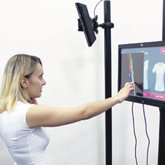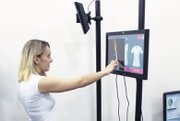TECHNOLOGY
AM4U Unveils Demand-Activated Manufacturing Technology
When I was invited to view a demonstration of a new apparel technology at California Polytechnic State University in Pomona, I wasn’t sure exactly what to expect. I assumed it would be a clunky piece of machinery accompanied by a PowerPoint presentation and possibly a few sample products of what the machine could produce. What I didn’t expect was a full bodyscan and a custom-made garment designed from scratch and shipped to my office in less than four hours.
Bill Grier, the founder and chief technology officer of Critical Mass Manufacturing, teamed up with Styku virtual body-scanning, Tukatech Apparel Technology, AIMS apparel management system and Eton Systems to launch a project aimed at directly connecting consumers to manufacturing, or “demand manufacturing.”
The project is titled AM4U, which stands for “apparel manufacturing made for you.”
The companies came together with Cal Poly Pomona’s Apparel Merchandising and Management program to work on the project, hoping to find a solution to waste and overproduction in the apparel industry.
Bud Robinson, a Cal Poly Apparel Merchandising and Management Advisory Board member who formerly served as president of Levi Strauss International and executive vice president of Gap Inc., had invited me to see the debut of their latest innovations.
“You’re the star of the show today,” Grier said, ushering me to my place in front of a scanner amidst a host of film crews capturing the process.
I took my spot in front of the depth scanner, a slim, black Microsoft Kinect box that was mounted to a pole to capture my full-body image. I held still, and it scanned my body, within minutes creating a 3-D avatar based on my proportions and displayed on a computer screen.
I was told to pick out the color and style of the shirt that was going to be created for me, while an assistant modeled my virtual-shirt selections on my avatar. I wanted to see what the technology was capable of, so I chose a combination of a turquoise body with blue camouflage sleeves and a gold university seal on the front.
“Remember, what you choose on the screen is what it’s going to look like in person,” I heard someone yell from the back, likely questioning my fashion choices.
The assistant recorded my selection online and then sent it off to Critical Mass, located 25 minutes away in Rancho Cucamonga, to be manufactured. Once the fabrics were dyed, the material would be driven to the school and cut and sewn together to make the garment. (When the project launches to the public, the fabric dyeing and manufacturing will all be done in one location.
“We’re at one hour and 17 minutes!” Grier yelled across the room after receiving a phone call from his factory updating him on the progress.
The excitement from the team was palpable as they anxiously waited to see their labor come to fruition in the form of their first customer-ordered, custom-made and custom-designed shirt.
The material arrived in less than three hours—breaking earlier records—and the team began cutting and sewing, keeping an eye on the clock. Shortly afterwards, the garment was completed and shipped to my office, totaling fewer than four hours from the time my body was scanned until the garment was designed, ordered, manufactured and shipped.
Speeding to market
Critical Mass’ Grier said the AM4U concept represents a huge shift for the apparel industry.
“It’s switching supply and demand to demand and supply,” Grier said.
Grier has developed a new process for dyeing fabric that operates with digital printing, does not require any liquids, and enables him to dye, print and imprint only the amount of fabric needed, all on one machine, with a quick turnaround. This process eliminates overestimated production runs and excess inventory, he explained.
“There are no minimum [orders], so you can change on the fly and produce every garment separately and at manufacturing speeds,” Robinson added.
By producing only the amount of apparel that’s sold, retailers can avoid losing money on excess production and no longer have to depend on cutting labor to reduce costs, which could help bring textile jobs back to the United States, Grier explained.
“High-profit production apparel creates a high enough margin to return the jobs and industry back to the U.S.,” he said.
In addition to speeding up manufacturing and reducing excess production, companies also save time by not having to stop manufacturing to clean the dye presses, he explained.
“We can provide high-speed manufacturing and manufacture 6,000 tops a day, and we don’t have to stop to clean the machines.”
Digital printing also allows customized orders to be manufactured without inventory, a “zero-inventory production system.” The entire inventory of a 10,000-square-foot warehouse can fit on one CD in the form of virtual merchandise, Grier said.
Currently, the apparel industry uses less than 2 percent digital printing, according to Lee Newsom, a Cal Poly Apparel Merchandising and Management Advisory Board member who is involved with the project.
With made-to-order manufacturing, customers who possess scanning technology can design and buy custom-made apparel online from home and have their merchandise delivered to their doorstep.
The group’s goal is to have a garment made in four hours or less from the time the order is placed and have it delivered within three days.
AM4U expects to offer roughly 20 different styles and color options that can be customized by customers or retailers and ordered online and manufactured one at a time, Robinson said. Currently, the print and dye technology only work with man-made polymers, such as nylon and polyester. The system is 12 to 18 months out from launching to the public for orders.
Mass customization in the classroom
Cal Poly Pomona brought in a scanning technologist from Kansas State University five years ago, which is also when they met Grier and became aware of his work in demand-activated manufacturing.
The school is building a model plant with the complete supply chain, including a new conveyor system developed by Eton Systems to accommodate mass customization.
“A quicker unit-production system reduces production time from days to hours and hours to minutes. It can do one unit at a time, and each unit can be tracked as an individual item,” explained Per Bringle, president of Eton’s U.S. support operations.
Peter Kilduff, the chair of Cal Poly Pomona’s Apparel Merchandising and Management Department, said the project is part of his larger vision for the university.
“We wanted to build the technology here,” he explained. “Scanning and mass customization in apparel manufacturing is part of the future, so we need to be a part of that.”























